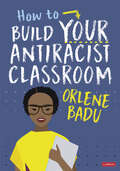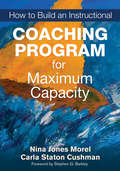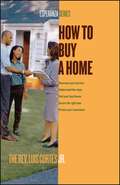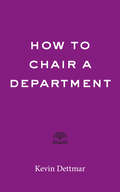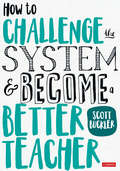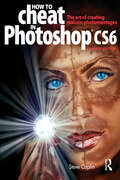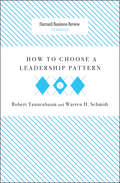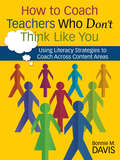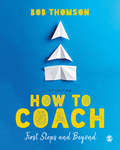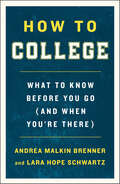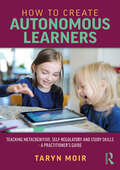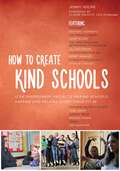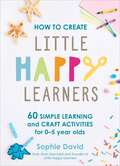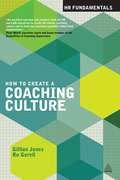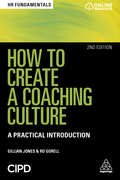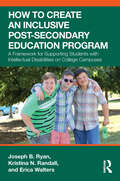- Table View
- List View
How to Build Communication Success in Your School: A Guide for School Leaders
by Karen Dempster Justin RobbinsThis book provides a step-by-step guide to achieve best practice communication within schools. Communication is a critical component in building strong partnerships with parents, attracting and retaining the best teachers, building and protecting a school’s reputation and, ultimately, in ensuring that students can be at their best. Aligned to the National Standards of Excellence for Headteachers (2015), as well as Ofsted and the Independent Schools Inspectorate requirements, it provides an ‘inside out’ approach to create and communicate a compelling vision, building leadership communication skills and supporting the day-to-day management of communication in schools. Full of practical strategies, audit tools and planning materials to help develop your communication approach, this guide covers key topics such as: attracting and retaining the best teachers; improving the effectiveness of leadership and management; building the reputation of the school; working with parents; and knowing what to do in a crisis. How to Build Communication Success in Your School is essential reading for headteachers, school leaders and all those interested in education management and leadership.
How to Build Your Antiracist Classroom
by Orlene BaduTaking on the pervasive issue of racism within education Badu offers a practical, no-nonsense guide on building an antiracist classroom. This book takes the reader on a journey from examining their own bias and racial literacy, to developing a diverse curriculum and improving the culture, to effecting wider changes across the school. Whether as an ally or recipient of bias in our society; this book will offer educators a guide to all the things we can do in the classroom to effect profound social change. If you seek to disrupt the cycles of systemic inequality that have existed in society and education for decades, this is the book for you. Orlene Badu is a Leadership & Education Consultant.
How to Build Your Antiracist Classroom
by Orlene BaduTaking on the pervasive issue of racism within education Badu offers a practical, no-nonsense guide on building an antiracist classroom. This book takes the reader on a journey from examining their own bias and racial literacy, to developing a diverse curriculum and improving the culture, to effecting wider changes across the school. Whether as an ally or recipient of bias in our society; this book will offer educators a guide to all the things we can do in the classroom to effect profound social change. If you seek to disrupt the cycles of systemic inequality that have existed in society and education for decades, this is the book for you. Orlene Badu is a Leadership & Education Consultant.
How to Build Your Baby's Brain: A Parent's Guide to Using New Gene Science to Raise a Smart, Secure, and Successful Child
by Gail GrossYour child’s DNA is not destiny; you are at the helm, guiding their course. The truth is, nature and nurture are in a delicate dance—if one goes too fast, the other one falls. Science tells us that early childhood experiences have the capacity to structure and alter the brain. That means you didn’t just supply your child’s DNA—you’re still shaping it. And it’s only by wielding this power that your child will activate their full potential. You are truly a gene therapist; manipulating and guiding your child’s genetic makeup based on the experiences you create for them. Contrary to what modern parenting trends have told us, parenting is much simpler than we dared to imagine. Great parenting comes down to one mission: to be prepped and present for the windows of your child’s development so that you can take full advantage of them and help your child become a smart, successful, self-sufficient adult. It doesn’t require formal training or a fancy degree—all it takes is getting involved. Once parents learn how to flip the right gene “switches,” they can expand the limits of their child’s potential and lay the emotional and intellectual groundwork that allows them to seize opportunities for success fearlessly, naturally, and enthusiastically. With a PhD. in education and a second in psychology, and forty years of experience as an educator, Dr. Gross combines an understanding of childhood development with practical and realistic tools to teach parents how to best take advantage of their child’s developmental windows. How to Build Your Baby's Brain translates the results from scientific studies about expanding consciousness and performance into day-to-day interaction between parents and children.
How to Build a Life in the Humanities
by Jr. Garrett A. Sullivan Greg Colón SemenzaA follow-up to the popular Graduate Study for the 21st Century: How to Build an Academic Career in the Humanities, this book seeks to expand professional development to include the personal aspects of daily lives in the humanities. It does so in response to a conviction that the contemporary academy has given rise to a host of complex personal challenges which demand serious reflection due to their direct impact on us as scholars, pedagogues, and university citizens. A collection of 25 short essays by leading humanists in all stages of their careers, How to Build a Life in the Humanities will delve into such under-discussed academic "life" issues as: maternity leaves; tenure-track stress; adjunct exploitation; post-tenure depression; personal relationships; exercise and hobbies; managing ambition; administrative burdens; institutional politics; classism; racism; sexism; and identity politics, among others. These candid, illuminating essays combine practical wisdom with meditativereflections upon the challenges of academic life and will be of interest to humanists of all ranks, from potential or beginning graduate students to seasoned professionals.
How to Build an Instructional Coaching Program for Maximum Capacity
by Nina Jones Morel Carla Staton CushmanChart your course for success: A guide for school and district leaders Research supports the value of coaches in improving school culture and facilitating change that leads to staff and student success. This comprehensive resource guides school and district leaders through the journey of developing and sustaining an effective coaching program. The authors engage readers with a nautical metaphor that outlines the planning and implementation process, including how to: Cast a vision for the coaching program Determine desired characteristics of instructional coaches Use data to evaluate and refine the program Communicate the benefits to leaders, principals, and teachers Design appropriate professional training and support
How to Build the Master Schedule in 10 Easy Steps: A Guide for Secondary School Administrators
by Steven S. KussinOffers a practical approach for creating a master schedule and features sample forms, worksheets, anecdotes, and mini case studies throughout, plus exercises that demonstrate each step.
How to Buy a Home
by Luis CortesIt's hard to think about buying a home. Where do you begin? How do you know if you're ready? What forms must you fill out? How can you avoid being taken advantage of? You might even feel that owning a home is so far beyond your means that it's unattainable. Purchasing a home is easier than you think. The Reverend Luis Cortés Jr. guides you through this complicated process and shows you how to turn your dream into a reality. The home-buying experience can be difficult, but a house provides more than just a roof over your head. It is an investment that promotes stability, enhances your well-being, and empowers you. Attaining all of this is simple. All it takes is learning the process, developing a plan, setting a goal, and working toward it. The Reverend Luis Cortés Jr. shows you how.
How to Chair a Department (Higher Ed Leadership Essentials)
by Kevin DettmarA practical, accessible handbook for chairing a department.Over the course of a typical academic career, most faculty will serve at least one term as chair of a department. It's a leadership and service role that's at the very heart of faculty satisfaction and student success, yet few receive any training on how to do the job. How to Chair a Department is a practical, accessible handbook for new and prospective chairs, providing both principles and practices for effective departmental leadership. Based on his dozen years of chairing departments, Kevin Dettmar provides invaluable advice on:• hiring tenure-track and visiting faculty• mentoring faculty colleagues at every stage of their careers• working with staff and other departmental administrators• managing department resources and budgets• meeting the needs of students• dealing with stress and conflict• connecting the department to the larger university or college as a whole• overseeing the department's curricula• maintaining a scholarly or creative profile• preparing for career moves after chairing a departmentHow to Chair a Department demystifies this important faculty position and argues that the role of chair, though sometimes seen as a burden, can prove to be a genuine opportunity for personal and professional growth.
How to Challenge the System and Become a Better Teacher (Corwin Ltd)
by Scott BucklerThis book empowers you to seek a deeper perspective on the education system and to develop as a critically informed teacher able to challenge the status quo appropriately – without losing your job! It focuses on the need to engage with research, to reflect critically and question your own teaching practice, so you don’t get stuck in bad or ineffective routines and can develop personally and professionally as a confident, versatile educator. Key topics include: · Understanding the pressure points in today’s education system · Developing your own educational philosophy · Reading and critiquing research to sharpen your thinking · How to make change happen
How to Challenge the System and Become a Better Teacher (Corwin Ltd)
by Scott BucklerThis book empowers you to seek a deeper perspective on the education system and to develop as a critically informed teacher able to challenge the status quo appropriately – without losing your job! It focuses on the need to engage with research, to reflect critically and question your own teaching practice, so you don’t get stuck in bad or ineffective routines and can develop personally and professionally as a confident, versatile educator. Key topics include: · Understanding the pressure points in today’s education system · Developing your own educational philosophy · Reading and critiquing research to sharpen your thinking · How to make change happen
How to Cheat in Photoshop CS6: The art of creating realistic photomontages
by Steve CaplinWith enough charm and wit to make learning Photoshop anything but taxing, Steve Caplin delivers the next instalment of the How to Cheat series, containing all the techniques you need to create and master the art of photomontage. Delivered in easy to follow step-by-step tutorials How to Cheat in Photoshop covers all the basics of selections and layers before moving onto top tricks and techniques for creating realistic works of art for business, pleasure, or something in between. An accompanying DVD is packed full of practice images and tutorial movies for you to working along with, plus bonus chapters to push your skills even further. Using a tweaked design that is clearer and fresher than previous editions this is the funnest way to master Photomontage.
How to Choose a Leadership Pattern (Harvard Business Review Classics)
by Warren H. Schmidt Robert TannenbaumSince 1922, Harvard Business Review has been a leading source of breakthrough management ideas-many of which still speak to and influence us today. The Harvard Business Review Classics series now offers readers the opportunity to make these seminal pieces a part of your permanent management library. Each highly readable volume contains a groundbreaking idea that continues to shape best practices and inspire countless managers around the world-and will have a direct impact on you today and for years to come.
How to Choose the Best Preschool for Your Child: The Ultimate Guide to Finding, Getting Into, and Preparing for Nursery School
by Jenifer WanaThe most useful tool out there for families about to embark on the search for a preschool!-Helen Cohen, director, Frances Jacobson Early Childhood Center, Boston. A must-have for parents of future preschoolers. Starting preschool is one of the biggest milestones in a child's life. With this comprehensive, step-by-step guide, you won't have to navigate the preschool process alone. Whether the nursery schools nearby enroll every child, or they're so competitive that they only accept a few applicants, this book has everything you need to know to choose and get into the right preschool for your child.
How to Coach Teachers Who Don't Think Like You: Using Literacy Strategies to Coach Across Content Areas
by Bonnie M. DavisThis how-to resource encourages teachers to write and reflect upon their practices in a unique approach to coaching that bridges content areas and honors distinctive learning styles.
How to Coach: First Steps and Beyond
by Bob ThomsonHow to Coach: First Steps and Beyond is an essential guide for anyone starting out in the coaching profession and for existing coaches seeking to develop their craft. It is a practical introduction to the theory, skills and art of coaching. This extremely practical introduction contains numerous case studies showing theory in action, aiding in understanding of how to apply theory to actual practice in a variety of settings. The book: Uses clear, uncomplicated language throughout Explains key ideas through brief illustrations from the author′s practice and quotes from leading writers on coaching Contains a wide selection of ideas, models and exercises to stimulate the reader′s learning Encourages students to try things out in conversation, and reflect upon and make sense of their experiences How to Coach is a must-have book for anyone interested in coaching skillfully, ethically and effectively.
How to Coach: First Steps and Beyond
by Bob ThomsonHow to Coach: First Steps and Beyond is an essential guide for anyone starting out in the coaching profession and for existing coaches seeking to develop their craft. It is a practical introduction to the theory, skills and art of coaching. This extremely practical introduction contains numerous case studies showing theory in action, aiding in understanding of how to apply theory to actual practice in a variety of settings. The book: Uses clear, uncomplicated language throughout Explains key ideas through brief illustrations from the author′s practice and quotes from leading writers on coaching Contains a wide selection of ideas, models and exercises to stimulate the reader′s learning Encourages students to try things out in conversation, and reflect upon and make sense of their experiences How to Coach is a must-have book for anyone interested in coaching skillfully, ethically and effectively.
How to College: What to Know Before You Go (and When You're There)
by Andrea Malkin Brenner Lara Hope SchwartzThe first practical guide of its kind that helps students transition smoothly from high school to collegeThe transition from high school—and home—to college can be stressful. Students and parents often arrive on campus unprepared for what college is really like. Academic standards and expectations are different from high school; families aren’t present to serve as “scaffolding” for students; and first-years have to do what they call “adulting.” Nothing in the college admissions process prepares students for these new realities.As a result, first-year college students report higher stress, more mental health issues, and lower completion rates than in the past. In fact, up to one third of first-year college students will not return for their second year—and colleges are reporting an increase in underprepared first-year students.How to College is here to help. Professors Andrea Malkin Brenner and Lara Schwartz guide first-year students and their families through the transition process, during the summer after high school graduation and throughout the school year, preparing students to succeed and thrive as they transition and adapt to college. The book draws on the authors’ experience teaching, writing curricula, and designing programs for thousands of first-year college students over decades.
How to Create Autonomous Learners: Teaching Metacognitive, Self-regulatory and Study Skills – a Practitioner’s Guide
by Taryn MoirTo achieve their full potential, it is essential that children develop skills to become autonomous learners, yet this skill does not come naturally to many learners. This book is a practical teaching and planning guide to the theory, practice and the implementation of evidence-based approaches to develop essential metacognitive and self-study skills. How to Create Autonomous Learners explains how to get students, parents and partners on board and how to implement these ideas across a class, school, or consortium. Areas covered include: • How to get children and young people ready to learn. • Why it is important to teach learning strategies. • Encouraging children to become more active in the process of learning while also nurturing the development of creativity. • How to harness learner motivation as metacognition and motivation are highly linked. Easily applicable in any classroom, this essential resource supports children’s development of important metacognitive, self-regulatory and self-study skills, and provides teachers and school leaders with evidence-based approaches for implementing these ideas with the support of parents, students and partners.
How to Create Kind Schools: 12 extraordinary projects making schools happier and helping every child fit in
by Henry Winkler Anthony Horowitz Friends Michael Sheen Jamie Oliver Families The Prince's Trust Jack Jacobs Charlie Condou Diversity Role Models Nocturn Dance Achievement For All Youth Dance England Baroness Janet Whitaker Jenny Hulme Linda Jasper David Martin Domoney Jane Asher 2faced Dance Beat Kidscape Claude Knights The National Autistic Society Ade Adepitan Kidscape Dance United Carers Trust Nspcc David Charles Manners Thrive Jill Halfpenny The Mentoring Befriending Foundation TravellersCelebrating the 30th Anniversary of Kidscape, the national charity that works to challenge and prevent bullying, this book offers readers an insight into a collection of innovative projects currently running in schools to promote inclusion, tolerance and kindness.<P><P> From a gay role model to a peer mentor, a dance workshop to a gardening club, an autism ambassador to a travelling Gypsy theatre group, the ideas demonstrate how much we have to teach our children about inclusion, how much kindness matters, and how much of a difference schools can make to children who don't always feel they fit. Joining forces with well-known charities and celebrity supporters including Anthony Horowitz, Jamie Oliver, Michael Sheen and more, these accessible, fun and effective projects are tackling issues such as bullying, homophobia, racism, and truancy, are supporting pupils who may feel isolated and excluded from their peer group, and are helping whole schools become happier, more successful settings.<P> This book will provide inspiration to all educational professionals, parents and volunteers looking for creative and practical ways to help individual children fit in and feel happy in their class.
How to Create Little Happy Learners: 60 simple learning and craft activities for 0-5 year olds
by Sophie DavidHow to Create Little Happy Learners presents an inspiring selection of learning and craft activities designed to promote a love of learning. Written by Sophie David, a former early years teacher and adviser who is now a stay-at-home mum with 3 children under 5, she is now channelling her knowledge and creativity to show-case the craft ideas she was using to keep her children entertained. Here, she offers over 60 fun-packed activities for children, all highlighting different skills (fine motor, phonics, maths, creativity, communication and independence). Split into topics ranging from animals to transport, Sophie not only offers crafting activities that involve children and can be used time and time again utilising everyday items, she also adapts each activity for different age groups (from 0-5 years) so you can reuse the book as your child grows.Some activities include:- Searching for animal fossils (phonics and creativity)- Bug Count (problem solving and maths)- Emotion stones (communication)- Creating sensory bags (baby play and motor skills)This book offers a bank of great activities to not only inspire a love of learning in your children but to make that journey a fun, craft filled one.
How to Create Little Happy Learners: 60 simple learning and craft activities for 0-5 year olds
by Sophie DavidHow to Create Little Happy Learners presents an inspiring selection of learning and craft activities designed to promote a love of learning. Written by Sophie David, a former early years teacher and adviser who is now a stay-at-home mum with 3 children under 5, she is now channelling her knowledge and creativity to show-case the craft ideas she was using to keep her children entertained. Here, she offers over 60 fun-packed activities for children, all highlighting different skills (fine motor, phonics, maths, creativity, communication and independence). Split into topics ranging from animals to transport, Sophie not only offers crafting activities that involve children and can be used time and time again utilising everyday items, she also adapts each activity for different age groups (from 0-5 years) so you can reuse the book as your child grows.Some activities include:- Searching for animal fossils (phonics and creativity)- Bug Count (problem solving and maths)- Emotion stones (communication)- Creating sensory bags (baby play and motor skills)This book offers a bank of great activities to not only inspire a love of learning in your children but to make that journey a fun, craft filled one.
How to Create a Coaching Culture
by Ro Gorell Gillian JonesHow to Create a Coaching Culture is a practical guide to developing an effective, efficient coaching culture in your organization. It demonstrates how to empower your workforce to achieve higher performance and greater business results. Specifically tailored to practitioner needs it offers an overview of coaching practice and aligns it clearly with organizational and HR strategy and objectives. Using a combination of practical tools, assessments, scenarios and case studies from best practice it will build your fundamental knowledge and equip you to take action by planning, pitching, and building a scheme. It also offers a complete framework for evaluating benefits and measuring return on investment.
How to Create a Coaching Culture: A Practical Introduction (HR Fundamentals #3)
by Ro Gorell Gillian JonesManagement approaches and workplace culture help determine employee productivity, morale, talent acquisition and retention, and organizational adaptability. How to Create a Coaching Culture is a practical guide to embedding effective coaching behaviours within an organization to empower and engage employees to perform at their best. Using a combination of practical tools, assessments, case studies and examples, it provides guidance on how to plan and develop a strategy aligned to your organization and its goals, engage the board to secure 'buy-in', and how to effectively measure and evaluate initiatives in every stage of the employee lifecycle.This fully updated second edition of How to Create a Coaching Culture contains new material on promoting employee engagement, reinventing performance reviews, and new and updated case studies from HarperCollins, British Airways and Leanintuit. Online resources include a series of downloadable templates and tools to use in practice, including a board report, communication strategy, development plan, and pre- and post-course training assessment.HR Fundamentals is a series of succinct, practical guides for students and those in the early stages of their HR careers. They are endorsed by the Chartered Institute of Personnel and Development (CIPD), the UK professional body for HR and people development, which has over 145,000 members worldwide.
How to Create an Inclusive Post-Secondary Education Program: A Framework for Supporting Students with Intellectual Disabilities on College Campuses
by Joseph B. Ryan Kristina N. Randall Erica WaltersThis essential guide offers a practical framework for developing a successful Post-Secondary Education (PSE) program for students with intellectual disabilities—one of the fastest-growing areas in higher education. Written by leaders of one of the nation's top PSE programs, this book distills their extensive experience mentoring over 90 colleges and universities into a practical, jargon-free guide. Featuring clear, actionable insights for creating a successful, tailor-made program, chapter topics include functional academics, independent living skills, and employment readiness. Written for college administrators, special education teachers, and parents, this book sheds light on how PSE programs not only enrich the college experience for students with intellectual disabilities but also equip them with the skills to thrive as self-sufficient adults.

